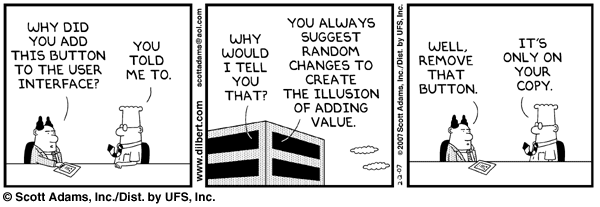
Editor’s note: Guest author Aaron Levie is the founder and CEO of Box.net
In the enterprise, simplicity simply doesn’t sell. Complexity, on the other hand, justifies costly software licenses and a swat team of consultants and systems integrators. It explains why updates are available every three years instead of being pushed weekly. And it even serves as an easy – but ultimately blameless – scapegoat for failed deployments and lagging user adoption. After all, the problems faced by today’s enterprises are incredibly challenging, and complex problems require equally complex solutions, right?
Wrong. This mindset needs to change – in fact, in order to survive, enterprise software must become simpler. Consumers are bringing new technology and expectations into the workplace where, more often than not, they’re forced to work with and around legacy platforms that disable rather than enable productivity. Simplicity will become the most important factor in business technology’s success, and to get there it can no longer be a dirty word in the enterprise. But it’s going to require some serious effort on the part of vendors and buyers alike.
We don’t want complexity, but don’t know how to value simplicity
While I deeply respect and admire the many innovations brought about by legacy solutions, the current state of technology in the enterprise kind of sucks. There’s a reason why a Google search returns more than 2 million results for “I hate Lotus.” Complexity is the culprit, and it takes many forms: tedious processes for common tasks like HR and expense reports, inability to collaborate beyond the firewall without IT intervention, and information silos without any security rationale. Not to mention the bad UI, error messages, upgrade failures, and downtime that users and IT departments contend with on a daily basis. And while no one explicitly desires cumbersome technology, we keep buying it because we’ve built a strong correlation between the number of features a solution has and the likelihood it will solve our problem. That, and you won’t get fired. While building or adopting the most feature-rich service looks great on paper, in practice it means that customers have signed themselves up for technology that can never be upgraded, unhappy end-users, and (paradoxically) inertia to move off tools that required so much time to implement and experts to maintain.
This bias isn’t limited to technology buyers or builders – the analysts I speak with often focus more on feature comparisons and product matrices than end-user experience and customer success. But that is changing, slowly. Gartner analyst Brian Prentice recently argued that simplicity is misunderstood and needs to be defined by the relevance and usefulness of features rather than the absence of features. But, we still have a long way to go before product comparisons focus more on customer success than feature parity. Gmail would never win a battle with Exchange on sheer volume of features, but the features that remain translate to better end-user adoption and satisfaction.
CIOs and IT administrators may be wary of out-of-the-box simple solutions, but they’re certainly not happy with the complexity of current solutions. A recent Forrester report on CRM deployments, for instance, found that “inflexibility” and “difficult upgrades” were cited as significant problems by over 75% of CIO respondents. Ouch. And IT adminstrators can’t even spend their way out of technology headaches – you will often see negative returns on overspending to solve IT problems. Out of the tens of thousands of IT buyers we talk to, the biggest benefit of moving to the cloud is the reduced support time and hassles, not just the reduction in cost. The need is certainly there for simpler solutions, but we need to prioritize and value simpler technology.

Building simple software takes vision and discipline
Mark Twain (or Ben Franklin, depending on your source) said, “If I had more time, I would have written a shorter letter.” This, in essence, is the challenge with simplicity. Building simple technology is not easy; it inherently takes much more work to reduce complex problems into simple solutions for people. Building products that suck is far easier, as David Barrett of Expensify pointed out in his post yesterday. Simplicity requires that you have user experience drive product management and solve problems with exceptional design. And it also means you sometimes have to say no.
It’s really, really hard to say no to customers. They want the world from your product, and they deserve it (really, they do). But letting customer feature requests or analyst reports exhaustively drive your product roadmap can be incredibly damaging. It’s not that they want something useless or that they’re wrong in their demands; it’s that they’re not seeing the underlying fabric of your product. And this is why it’s so crucial to have a vision: if you don’t know where your product is heading in a fundamental way, your customers or competitors will take you in too many directions. As Rypple co-CEO Daniel Debow points out, traditional enterprise software sucks because vendors relinquish control of product roadmaps to close deals: “Buyers may not realize it, but the many hours they spend crafting the perfect RFP are really spent designing the software that comes out the other end.” Build for all your potential customers’ potential problems and before you know it, you’ll become the more complex competitor that you’ve trying to disrupt. The majority of software and services tend to forget this as soon as they go from focusing on user experience (market fit) to scale.
There will always be a few really complex problems that require complex solutions. But for the vast majority (read: 95%) of use cases, simplicity will suffice. Where complexity is necessary – whether it’s to build a specific workflow, integration, or solution for a particular vertical – solve it through customization. Abstract the core areas of your product from the parts that can be modified by a developer or customer, making sure the core and default use is still simple. The best products in the world can do as much or as little as customers want without you having to think twice. The economic upside of this is obvious, of course, as you’ll now have a rich ecosystem of integrators, value-added resellers, and professional service firms that can participate in your success.
You can’t change market expectations, but you can create new markets
So how does Box make enterprise content management simple? We don’t, really. We redefine it. If Box tried to compete based on the laundry list of functionalities that have come to define ECM, we’d quickly lose to SharePoint, which has a sufficiently filled-out offering and deep penetration. An existing market has certain expectations because of the companies that have come before you, and you can’t just build to meet these standards, nor should you set out to change them immediately. Instead, find the dimensions where you can make things materially simpler, and build a solution that gives users more power with fewer features. Start with a department and end-users, solve their problem, and expand.
Or look at the problems your product is already solving, and expand into entirely new, under-served markets. For instance, there’s an explosion of demand for business software in the mid-market. Companies in the 50-1,000 employee range are large enough to have challenging and interesting problems, and for years they’ve either lacked the technology to address them, or they’ve had to buy into more expensive solutions than their needs require. Bring your software to new organizations and new markets, and if you build the best product, it will grow. It’s far easier to maintain simplicity by finding the groups that have the problem you already solve really well, than by trying to reach legacy markets by building new features.
Take MySQL, who redefined the database market by offering a simpler database for every developer in the world. They now own a huge chunk of the market without having to compete with Oracle in the process. GoodData, Zendesk, Assistly and Workday have all leveraged the cloud to build simpler solutions in markets dominated by big, clunky, overly comprehensive systems. Salesforce.com, with a $15B market-cap, has shown how to build a very large enterprise by selling a little to a lot of customers: an average Salesforce.com customer only has an estimated 15-20 seats on the service.

How to build a simpler enterprise:
If you’re in IT: Look throughout your organization and find the areas where employees spend a disproportionate amount of time or run into problems on a specific set of tasks. Enabling technologies in these areas will pay huge dividends for your organization. Pilot tools with employees, or find out what they’re already using before implementing something site-wide — more likely than not, a simpler solution has already been adopted. Consider the intangible value of implementing simpler technologies: less support, less maintenance, less headache, more productivity. Demand simplicity from your vendors.
If you’re building software: Invest disproportionately in design, usability and engineering. Create transparent feedback loops to make sure your product is being successful. Building great, usable technology is not subjective. Constantly test what you’re building on users and gather data consistently. Reduce features sets, allow for customization, and stick to your vision. Sell based on the complexity of the problem and the simplicity of the solution.
If you’re a business manager or end-user: Talk to your IT department. Explain why your existing technology isn’t meeting your needs, and offer to pilot new technologies. Use your IT organization as a source of knowledge and innovation rather than just a support center, and they’re far more likely to implement user friendly, innovative technologies.
Simplicity will be incredibly beneficial, and it will also be incredibly disruptive. The losers will be the technology providers who are either too lazy or too overextended to settle on a vision; the winners will be workforces that are empowered by usable technology and the vendors that serve them.
Photo credit: Getty